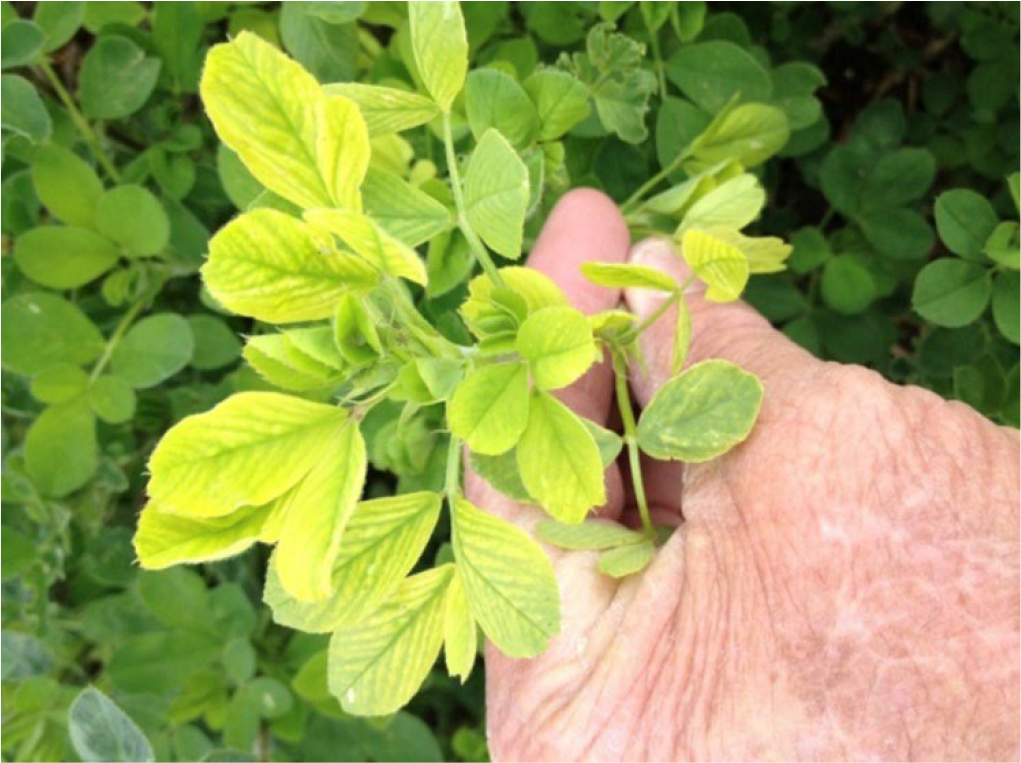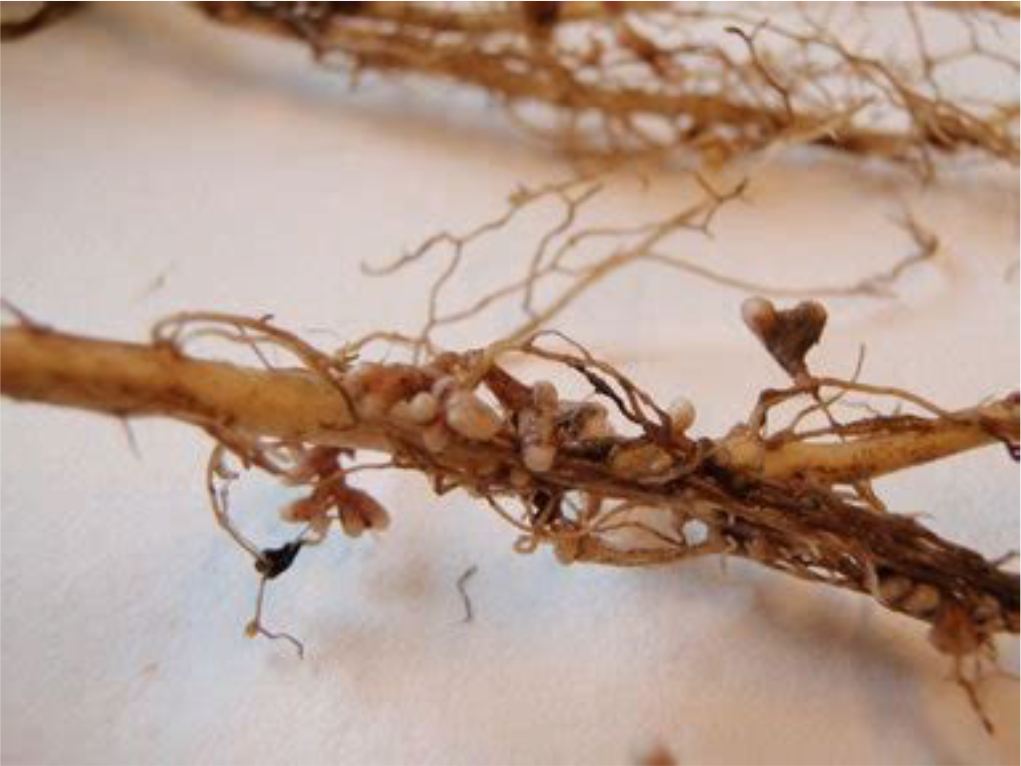⇦ Back to Crop Management Home
¶ Introduction
Inoculating alfalfa seed at planting with a culture of Rhizobium meliloti bacteria helps assure that the alfalfa will form root nodules and can fix enough nitrogen to produce a high protein hay crop.
There are times when nodules do not form on the alfalfa root system. In this case, growth is stunted, plants become nitrogen deficient, and the stand fails. Growers are often forced to destroy and replant such a stand. This means a $25 to $50 loss of establishment costs (seed, herbicide, labor) and an additional loss of one year's hay production.
Emergency reinoculation is one alternative to replanting. “Emergency” inoculation has at best a 50:50 chance of success, but if it works it is much cheaper than completely replanting a field.
Nodules can develop if inoculant is placed in contact with the growing alfalfa roots under cool (but not cold), moist conditions. Inoculant can be applied in one of three ways: with a ground, a fertilizer spreader, or a seed drill. Research by Dr. D.S. Chamblee, North Carolina State University and limited grower experiences have verified this technique.
¶ When to Reinoculate
Alfalfa root systems should be checked for nodule development 30 days after seeding. Healthy, effective nodules have pink centers. Ineffective nodules are green, white, or brownish in the center. The true cause of nodulation failure needs to be uncovered. Weather or soil conditions may have prevented nodule establishment. The inoculant may have been the wrong strain of Rhizobia or the bacteria may have been killed by temperature extremes. If the problem is soil pH, fertility, or water management, it must be corrected or reinoculation may fail.
¶ Timing
Emergency reinoculation should be done as soon as possible, ideally four to five weeks after seeding. Chamblee had poor results by waiting eight weeks after seeding to reinoculate a fall seeded stand, probably because of soil temperature.
If there is sufficient soil nitrate to carry the alfalfa through until spring, the treatment can be applied then. Nodules normally become apparent about 30 days after reinoculation. If soil temperatures drop down between 40° to 50, the bacteria may not form nodules until the following spring.
¶ Figure 1. Nitrogen Deficiency in Alfalfa

¶ Rates and weather conditions
Chamblee's research shows that low rates of peat-based inoculant (1½ to 2 pounds of material per acre) are adequate to reestablish nodulation. Higher rates showed no significant advantage.
The key to success is applying the inoculant to moist soil and keeping the soil moist for several days after treatment. The ideal situation for reinoculation is to apply the inoculant on a cool, cloudy day, preferably in late afternoon. The Rhizobium bacteria are very sensitive to UV radiation, so exposure to sunlight must be minimized.
Irrigation or precipitation right after application is essential for success. Moisture helps move the inoculant into the surface soil and provides a good environment for Rhizobia reproduction.
Dryland alfalfa stands have only been successfully reinoculated when they were treated immediately before a rain. Irrigated fields should be watered as soon as they are treated. High temperatures during or immediately after treatment can dry out the surface soil, killing the Rhizobia.
Nodules do not form well under cool soil temperatures. Emergency reinoculation when soil temperatures are below 40°F usually fails according to Chamblee.
¶ Sprayer Application
Ground spraying is probably the simplest method of applying inoculant. A slurried mixture of 1½ to 2 pounds of peat-based inoculant in 30 to 40 gallons of water per acre can be sprayed directly onto the soil surface. Rain or irrigation after application is crucial for this method to work, but had been successfully used in the ServiTech area.
Chamblee found "Pelinoc" (made by Nitragin) to be the best material for spraying because it seems to be more finely divided that many other inoculants and rarely clogged nozzles. Other inoculants can be used by prescreening the mixture through a 100-mesh screen.
High volume spray nozzles used without screens should help prevent clogging. Suggested nozzle types are flooding flat fan, whirl chamber, or RA "Raindrop". Continuous agitation is recommended to maintain the slurry in the spray tank when treating large acreages.
¶ Topdress Application
Rhizobia bacteria will be killed if placed in direct contact with fertilizer, so it should never be used as a inoculant carrier.
Sticking agents are not needed with reinoculation as they are with planting time treatment. Sticking agents will only cause clogging and gumming during application.
Alfalfa stands can be topdressed with a spinner-type fertilizer spreader by mixing 5 pounds of granular inoculant with 1000 pounds of sand or lime per acre. Lime will cause less wear on the equipment than sand, but may be more difficult to mix. If low pH is a problem, lime is a better choice.
A peat-based inoculant can be mixed with a carrier such as cottonseed meal. The use of a fibrous feed-based carrier eliminates the need for a sticking agent. Use 40 to 50 pounds of meal as the carrier for 1 to 2 pounds of inoculant. This amount should be broadcast over 1 acre.
One half of the carrier/inoculant combination should be broadcast going in one direction across the field and the other half broadcast in a perpendicular direction. This application method will provide a more uniform coverage with less streaking.
¶ Figure 2. Nodules on Alfalfa Root Fixing Atmospheric Nitrogen

¶ Seed Drill Application
Reinoculation can be somewhat protected from drought by applying the inoculant with a seed drill. This method may work best in dryland situations when rain is not immediately forecast. The application may fail if the soil dries out.
Peat based inoculant (1-1/2 to 2 pounds) mixed with 50 to 100 pounds of sand or sawdust per acre can be drilled directly into an established stand. Chamblee's research did not find any advantage to higher inoculant rates.
The drill should be set shallow, about 1-inch deep, to avoid damaging alfalfa roots. Rhizobia can move short distances in the soil - about 4 to 6 inches - so good distribution is important, but not essential.
Plants between the rows were missed when the inoculant was drilled in. However many of these plants eventually formed nodules.
Sand can abrade and damage the drill mechanism, but sawdust worked as a suitable carrier in the North Carolina research.
¶ References
Rogers, Warren, & Chamblee. 1982. Remedial postemergence legume inoculation with Rhizobium. Agron. Journ. 74:613-618.
Smith, Lacefield,& Vincelli. 2009. “Emergency” Inoculation for Poorly Nodulated Legumes. Plant Pathology Fact Sheet # PPFS-AG-F-04. Kentucky Coop. Ext. Serv. 2 pg.